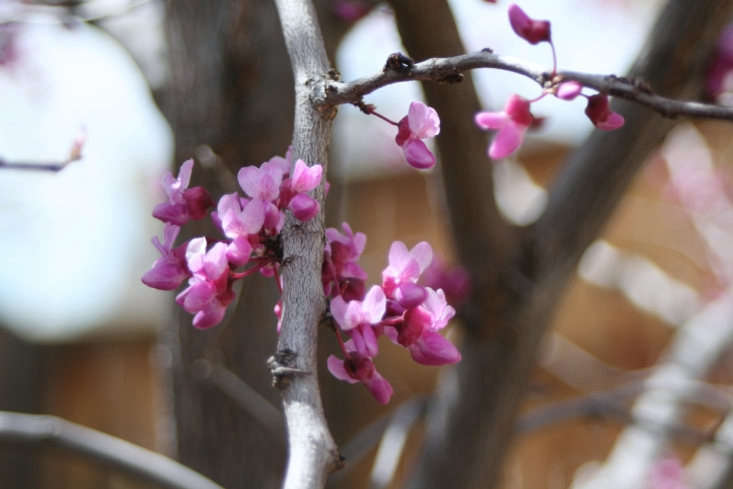Eastern Redbud, Cercis canadensis: “Pea Flowers”
In early spring the distinctive and profuse flowers of eastern redbud (Cercis canadensis), a small tree native to eastern and central North America, defy color-description. Are they pink? Rose? Purple? Lilac? We need a new redbud word. Clustered against the gray bark of their leafless branches, the darker buds (magenta?) open to a thick and pale pink pelt, giving the tree a psychedelic and slightly prehistoric appearance.
Read on to learn how to cultivate this native tree, and why.
Photography by Marie Viljoen, unless otherwise noted.



Equally happy in sun or semi-shade, redbud is a natural understory tree which also adapts well to the high shade created by clusters of city buildings. Cold hardy redbud will grow in USDA zones 4 to 9. Its one steady requirement is ample moisture; this is not a tree for dry areas.
The famous pea-like flowers are not only pretty but edible. Add a handful to a salad or to summer rolls for a burst of crisp sweetness.


If you would like an alternative to green leaves, ‘Forest Pansy ‘ has deeply purple foliage.

The appealingly heart-shaped foliage rounds out the slender trees and creates deep shade beneath the branches. In fall the leaves turn a bright yellow.
Cheat Sheet
- Some subspecies of Cercis canadensis will tolerate drier conditions: Ask for C. canadensis var. mexicana and C. canadensis var. texensis at native-plant nurseries.
- Redbud is the state tree of Oklahoma.
- Native Americans enjoyed the flowers as food.
- George Washington and Thomas Jefferson grew the tree in their gardens at Mount Vernon and Monticello.

Keep It Alive
- Native to states with high annual rainfall, eastern redbud needs plenty of moisture and good drainage.
- Apply a layer of mulch to conserve soil moisture (do not mound it around the trunk, or the tree will rot).
- If planted in a container, choose one 24 inches or more in diameter, and monitor water closely (do not forget essential drainage holes).
- Redbuds are very stressed by a brief drought; stress makes them prone to disease (just like humans).
- If a branch is injured, prune it off cleanly: Injuries serve as portals for the fungi that cause dieback and Verticillium wilt in redbuds.

See more of our favorite flowering trees in our curated design guide to Trees 101, including Apple Trees 101, Dogwood Trees 101, and Lemon Trees 101. For more inspiration, see:
- Cherry Blossoms: 6 Flowering Trees to Grow at Home
- 8 Cold-Climate Flowering Shrubs and Small Trees for Early Spring
- Flowering Magnolias: 7 Favorite Trees to Plant












Have a Question or Comment About This Post?
Join the conversation (2)